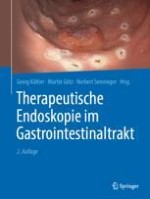Zusammenfassung
Im gesamten Gastrointestinaltrakt können Blutungen unterschiedlicher Schwere und Intensität auftreten. Dabei werden die verschiedenen Blutungen je nach Ort der Entstehung unterschieden (obere, mittlere und untere gastrointestinale Blutung). Der obere GI-Trakt (OGIT) reicht hierbei vom Ösophagus bis zur Papilla Vateri. Von einer mittleren gastrointestinalen Blutung (MGIB) spricht man, wenn die Quelle zwischen der Papilla Vateri und dem terminalen Ileum liegt. Die untere GI-Blutung (UGIB) – vom Rektum bis zum terminalen Ileum – kann in der Regel durch die Koloskopie behandelt werden. Anatomisch (alte Nomenklatur) spricht man von einer oberen gastrointestinalen Blutung (OGIB), wenn diese proximal des Treitz’schen Bandes lokalisiert ist, die UGIB dagegen ist per definitionem distal des Treitz’schen Bandes lokalisiert und reicht von der Flexura duodenojejunalis bis zum Anus.











